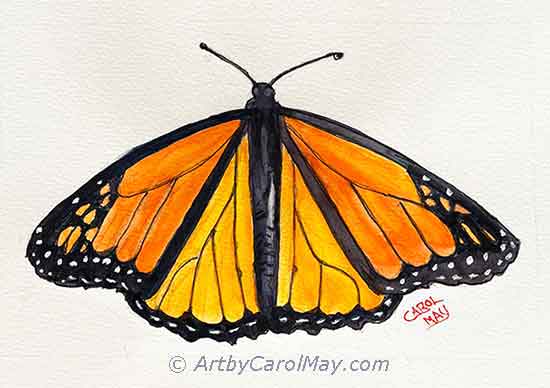- Home
- Paint a Beach
Uncover the Secrets on How to Paint a Beach
By guiding you comprehensively on how to paint a beach, you'll feel empowered to explore your artistic boundaries.
This page takes away the mystery and introduces you to the essential techniques and materials you'll need to create a stunning coastal painting.
Imagine the sounds of the crashing waves, the salty sea breeze and the warmth of the sun.
Transporting these sensory experiences onto a canvas can feel like a daunting task. But with the instructions and a dash of inspiration, you can do a beach painting.
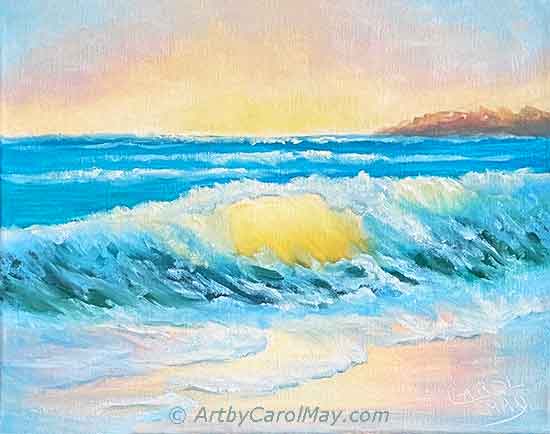 Seascapes are exciting to paint!
Seascapes are exciting to paint!what do we use for the beach painting
The painting may be done with oil paint, alkyds or acrylics. This is an alkyd painting. Alkyds are my favorite 'oil paint' because they dry much faster than oils, but not as fast as acrylics.
As an affiliate I earn from Amazon sales with no extra cost to you. Learn More
It's on an 11x14 stretched canvas. I recommend smaller canvases for practice and learning. They take less time and materials to complete. Canvas boards are also good for practice.
Flat brushes work great for seascapes. The brush size depends on your canvas size, judge appropriately. This painting used #2, 4 and 6 flat or filbert 'ad' hog bristle brushes and a synthetic #1 round.
Paint colors: Cadmium or Indian Yellow, Cadmium Red or Cad. Red Light, Burnt Sienna, Cerulean Blue, Ultramarine Blue and Viridian.
Clean-up for both oils and alkyds use 'ad' Gamsol odorless mineral spirits.
Steps on How to Paint a Beach Perfectly
This painting is done with five steps. That's how to paint a beach, paint the sky, the sea, the wave, the sand and finish with the details.
First put an outline sketch on the canvas. Thinned yellow paint is best, because it's easy to paint over.
Pencils may be used. Sketch with a hard pencil because dark graphite from a soft pencil is difficult to cover.
Notice, the horizon line is about one third down from the top. The wave is on an angle and the foam lines on the beach generally follow the same angle.
start painting the sky
We will paint a soft sun-lit sky with the sun near the horizon. The main emphasis of this painting is the wave and beach, so we won't paint clouds. Later, I will be doing a page on how to paint clouds.
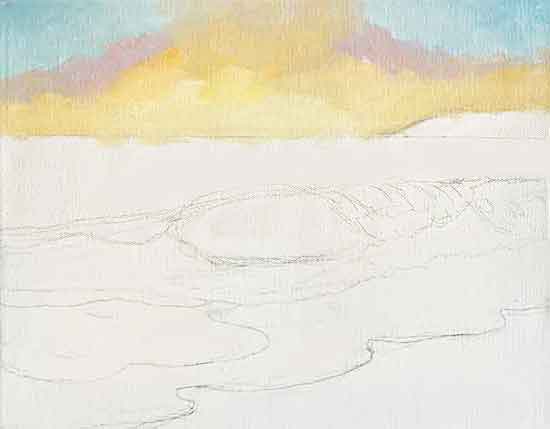 Leave the sky unblended at this time.
Leave the sky unblended at this time.Each of the sky colors are mixed with white.
Start painting at the horizon with a mixture of yellow and white. As we paint higher up the canvas, use less white and more yellow. Add more white by the horizon where the sun would be.
Add a tiny bit of red to the mixture for a rosy color. Paint it above the yellow.
The final color farthest from the sun is Cerulean Blue with a speck of Burnt Sienna to soften the blue.
next the background water
The horizon line will always be level, even though the wave is at an angle.
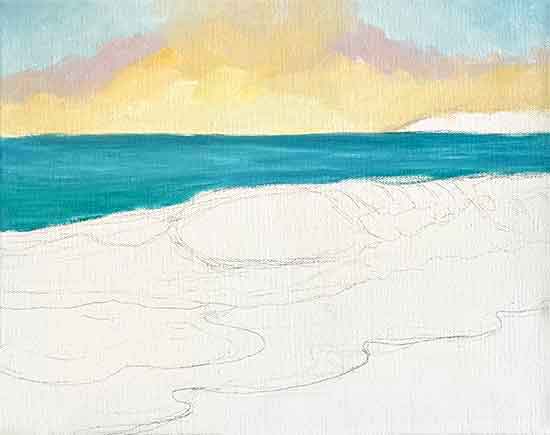 The ocean is darkest at the horizon.
The ocean is darkest at the horizon.Mix Cerulean Blue with Viridian and speck of Ultramarine to naturalize the color. Then add white to get your desired value.
- Paint from the horizon down.
- The water is the darkest and bluest at the horizon.
- It gets lighter and greener, as we paint down the canvas.
- Notice it is the greenest behind the left part of the wave.
- Stroke the paint on from side to side.
- Don't worry about streaks, in fact leave them for some color variations.
We let the water set for a while. That makes it easier to paint the small waves later.
Next underpaint the wave
We underpaint the wave before doing any foam.
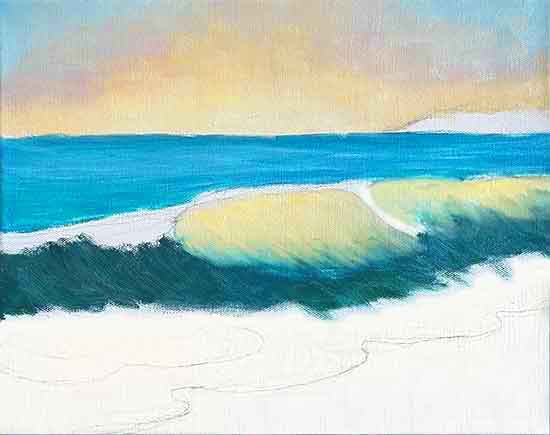 Paint the shadowed part and the eye of the wave.
Paint the shadowed part and the eye of the wave.First, mix a dark color for the base of the wave. Use Cerulean, Viridian and a little bit of Ultramarine and Burnt Sienna to darken and neutralize the color. Do not use any white, only pure color.
Paint the shadowed base of the wave. Stroke the paint on in the direction of the water movement. The base of the wave is mostly horizontal even though the top of the wave is angled.
Second, mix some yellow and white for the translucent part of the wave.
Paint it on in the direction of the water movement. Do some blending where it meets the base color.
Leave the foam areas unpainted.
Third, gently blend the sky colors together where they merge with a different color.
underpaint the beach
The sky colors are reflecting onto the wet beach sand.
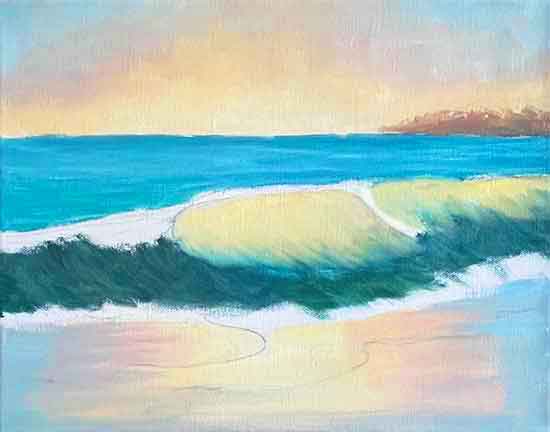 Paint the beach and background land.
Paint the beach and background land.Paint the sky colors on the beach with horizontal strokes.
Gently merge and blend the colors together. A little bit darker color at the bottom edge of the canvas will keep the viewer's eyes in the painting.
Paint a background point of land in the distance. Paint sea oats, shrubs or palm trees, whatever you desire. Create a soft edge by gently blending their tops into the sky. Soft edges keep it in the distance.
paint the shadows
Paint the shadow portions of all the foam.
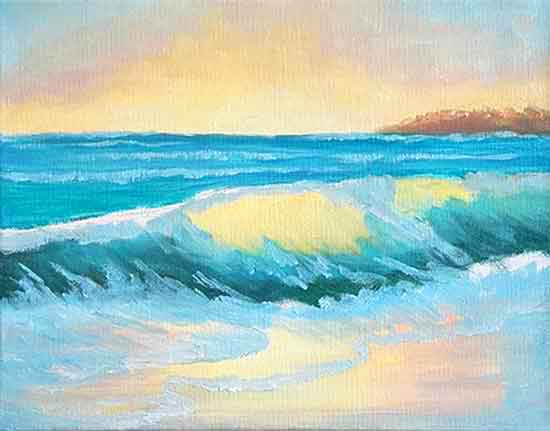 Paint the shadowed foam.
Paint the shadowed foam.Mix a soft blue for the shadow parts of the foam. Use Cerulean with a speck of Ultramarine and Burnt Sienna with white.
First paint some small waves in the background ocean water.
Hold the brush handle parallel to the canvas and the bristles' side edge toward the canvas. Pull the brush gently to put the paint on without mixing it with the underpainting.
Second, paint all the shadow parts of the foam on the wave. Pull some foam trails up the face of the wave, painting in the direction of the water's movement.
Third, paint the foam on the beach. Use a gentle touch to pull the color over the reflected sky colors. Do not blend.
the highlights and finish details
Mix the foam highlight color with yellow and white. Paint highlights with a loaded brush and a very gentle touch.
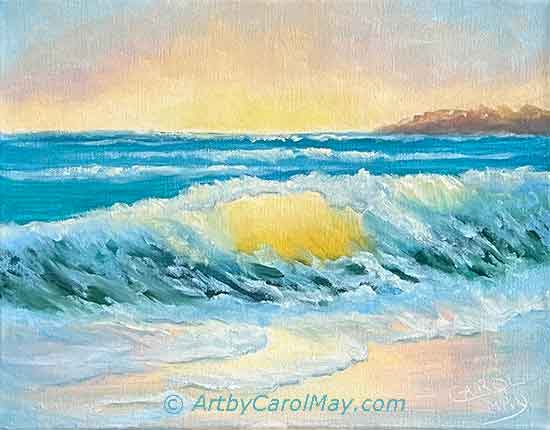 Highlight all the foam touched by sunlight.
Highlight all the foam touched by sunlight.Hold the brush parallel with the canvas and pull it lightly across the sun-lit areas. If you hold the brush upright like regular painting, it will mix with and pull up the underpaint.
- Paint a few highlights in the center of the background water.
- Highlight the top of the main wave on about the center two-thirds of the wave.
- Highlight some areas of the beach foam using less yellow and more white.
- Pull additional shadowed foam trails up on the wave.
- Use a small brush to shadow under the top foam on the translucent part of the wave.
- Also put a few shadows under the beach foam in a few places.
- If you wish, add more yellow to the sun area of the sky.
now you know how to paint a beach
Painting art is about expressing yourself, and what better way than painting a beach scene.
This page is dedicated to help you paint with confidence, express your creativity, and enjoy the entire process. Do view more pages on ArtbyCarolMay.com for additional artistic adventures.
start painting your beach today!
Recent Articles
-
You Can Paint Butterfly Art!
Apr 21, 24 08:31 AM
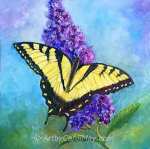 Unlock your creativity and start painting butterfly art. Discover the techniques of painting realistic butterflies. Link to 5 different pages on how to paint butterflies with tips and valuable insight…
Unlock your creativity and start painting butterfly art. Discover the techniques of painting realistic butterflies. Link to 5 different pages on how to paint butterflies with tips and valuable insight… -
Learning to Paint
Mar 29, 24 12:00 PM
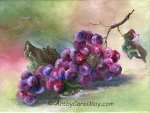 Learning to paint is fun! Millions of people are painting and you can too!
Use these five easy things to jump start your painting journey.
Learning to paint is fun! Millions of people are painting and you can too!
Use these five easy things to jump start your painting journey. -
Easy Butterfly Painting: Watercolor Monarch Step-by-Step Tutorial
Mar 25, 24 03:39 PM
Get creative with an easy butterfly painting tutorial. Discover the joy of drawing and painting a vibrant Monarch Butterfly with simple watercolor techniques. -
Overcoming an Artist's Block
Mar 15, 24 12:00 PM
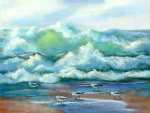 How to survive an artist's block. All artists can have blocks or delays, but we get over it.
What is an art block? How do we get started painting again?
How to survive an artist's block. All artists can have blocks or delays, but we get over it.
What is an art block? How do we get started painting again?
Recent Articles
-
You Can Paint Butterfly Art!
 Unlock your creativity and start painting butterfly art. Discover the techniques of painting realistic butterflies. Link to 5 different pages on how to paint butterflies with tips and valuable insight…
Unlock your creativity and start painting butterfly art. Discover the techniques of painting realistic butterflies. Link to 5 different pages on how to paint butterflies with tips and valuable insight… -
Learning to Paint
 Learning to paint is fun! Millions of people are painting and you can too!
Use these five easy things to jump start your painting journey.
Learning to paint is fun! Millions of people are painting and you can too!
Use these five easy things to jump start your painting journey. -
Easy Butterfly Painting: Watercolor Monarch Step-by-Step Tutorial
Get creative with an easy butterfly painting tutorial. Discover the joy of drawing and painting a vibrant Monarch Butterfly with simple watercolor techniques. -
Overcoming an Artist's Block
 How to survive an artist's block. All artists can have blocks or delays, but we get over it.
What is an art block? How do we get started painting again?
How to survive an artist's block. All artists can have blocks or delays, but we get over it.
What is an art block? How do we get started painting again?






